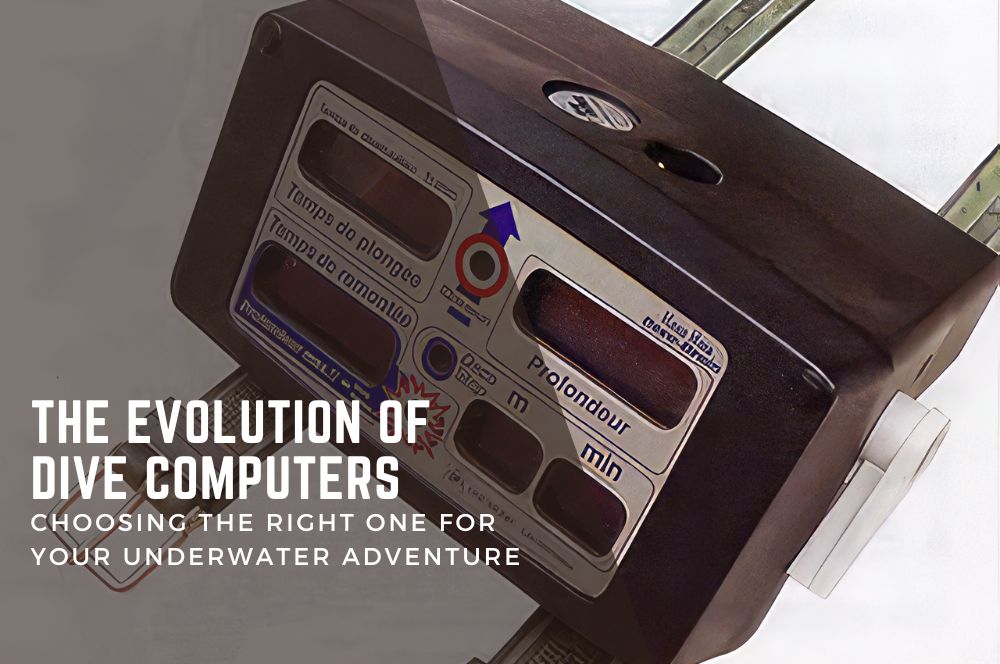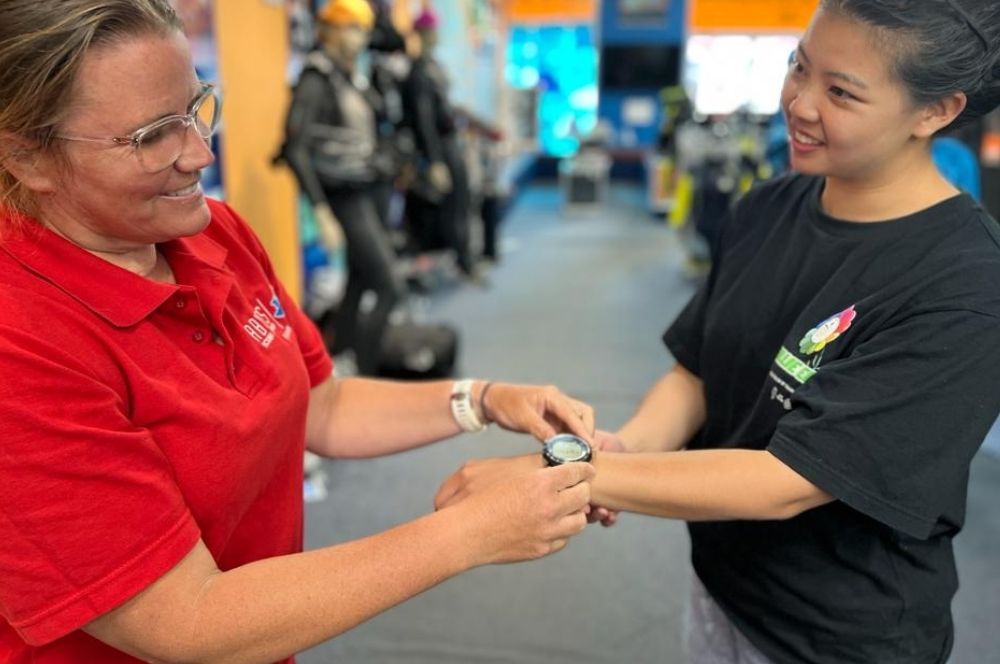You have 0 product(s) in your cart.
Abyss Scuba Diving
The Evolution Of Dive Computers: Choosing The Right One

Diving Computer Evolution: Choosing the Right One for Your Underwater Adventure
The personal dive computer play a pivotal role in revolutionizing underwater exploration, offering individual divers a wealth of information at their fingertips to monitor key aspects such as depth, duration, nitrogen absorption, and air supply, thereby enhancing safety and enjoyment. Let’s delve into the significance of dive computers in the realm of diving technology.
History and Evolution from Analog to Digital
The journey of the dive personal computer traces back to the 1950s when analogue ‘decompression calculators’ made their debut under the testing lens of the US Navy. The transition to digital took a significant leap with the introduction of the first digital dive computer by Swiss manufacturer Divetronic AG in 1983. This marked a turning point in dive technology, paving the way for more sophisticated algorithms and enhanced diver safety. The iconic Aladin Pro from UWATEC in 1987 further solidified the importance of precise decompression models in diving. Popular brands like Suunto, Scubapro, and Oceanic have also significantly contributed to the evolution of dive computers, ensuring quality and innovation for divers of all skill levels.
The history of dive computers begins in the 1950s with the U.S. Navy's testing of analog 'decompression calculators.' The evolution to digital dive computers is attributed to the Swiss company Divetronic AG, which released the Hans Hass DecoBrain in 1983. By 1987, UWATEC's Aladin Pro, utilizing algorithms from decompression theory pioneer Albert Bühlmann, dominated the market. The 1990s saw a shift from analog watches and dive tables to dive computers, as scuba diving became more accessible. This shift allowed for longer dive times due to the continuous recalculations of no-decompression limits. Additionally, this period introduced various styles of dive computers, such as console models that combined the computer with other vital diving instruments, providing an alternative to wrist-mounted units.
The original UWATEC Aladin Pro, released in 1987, was a groundbreaking innovation in the world of diving. It boasted several standout features that made it a preferred choice among divers. The Aladin Pro utilized Bühlmann’s algorithms to provide accurate and reliable decompression models, enhancing diver safety. It featured a straightforward digital interface that displayed essential dive data such as depth, dive time, and no-decompression limits. Moreover, the Aladin Pro was known for its robust and durable design, capable of withstanding the harsh underwater environment. This early model set a high standard for dive computers by successfully merging precision, usability, and reliability.

Advancements in Dive Computer Features
Since the release of the Aladin Pro, dive computer technology has seen significant advancements. Modern dive computers have integrated more sophisticated algorithms, providing even more accurate decompression models and catering to various diving styles, including recreational, technical, and freediving. Today’s models often come with enhanced digital displays that are not only more detailed but also easier to read underwater. Features such as wireless air integration, which allows divers to monitor their tank pressure and air supply directly on the computer, have become more common. This integration helps divers keep track of their remaining air, ensuring they know when to start their ascent. Many dive computers now offer GPS tracking and digital compasses, further aiding navigation. Additionally, modern dive computers often support Bluetooth or Wi-Fi connectivity, enabling divers to sync their dive logs with smartphones and other devices for comprehensive dive management. The evolution of these features has transformed dive computers from basic safety tools into multifaceted devices that significantly enrich the diving experience.
Dive computers are crucial for tracking dive information, including time, depth, and other essential metrics, to ensure safety during underwater adventures.
Dive computers have become essential equipment today, offering a vast array of choices across different budget levels.
Introduction of Avelo Mode in 2024
2024 ushers in a new era for dive computer technology with the introduction of the game-changing Avelo Mode in Shearwater and Scubapro dive computers. This revolutionary mode offers real-time feedback on crucial diving techniques such as buoyancy control, kick efficiency, and breathing patterns, redefining how divers interact with their devices underwater.
Best Dive Computers of 2024
In the landscape of dive computers, selecting the right model is paramount. The best dive computers of 2024 not only include the innovative Avelo Mode but also boast a range of features tailored to different diving preferences and skill levels. These devices serve as essential companions for both novice and experienced divers seeking optimal performance and safety underwater.

Pitfalls of Overbuying
One of the common issues with dive computers is that divers, especially new ones, often purchase high-end models loaded with features they don’t yet know how to use. These sophisticated dive computers come packed with functionalities that can be overwhelming for beginners and even go unused by many seasoned divers. For example, advanced gas-switching capabilities, customisable algorithms, and surface interval calculations may be unnecessary for someone still mastering the basics of buoyancy and navigation. Consequently, divers end up paying a premium for features they don’t need, leading to an underutilisation of the device’s capabilities.
For novices, investing in a basic dive computer is a more logical and economical choice. By opting for a simpler model, new divers can focus on mastering essential diving skills without the distraction of advanced settings and complex interfaces. The money saved can be better spent on critical equipment such as a higher-performance regulator, which has a direct impact on the diving experience by providing smoother and more efficient breathing underwater. A basic dive computer still offers crucial features like depth tracking, no-decompression limits, and ascent rate monitoring, which are essential for safe diving practices.
As divers gain experience and develop a deeper understanding of their needs, they can then consider upgrading to a more advanced dive computer. By that time, the features they require will likely be more affordable and their familiarity with diving technology will ensure they make an informed purchase. This incremental approach not only saves money but also aligns better with a diver’s growing skill set and diving aspirations. Ultimately, carefully planning when to upgrade dive equipment ensures that divers get the maximum value and functionality from their investments.

Conclusion
Dive computers have undeniably revolutionised the way we explore the underwater world, offering safety, convenience, and enhanced diving experiences. From their early beginnings with analog devices to the sophisticated digital models of today, these gadgets have become vital tools for divers of all levels. As we've explored, it's important to choose a dive computer that aligns with your current skill level and diving objectives to avoid unnecessary costs and underutilisation of features. With the right dive computer, each dive becomes a safer and more enjoyable journey. Whether you're just starting or a seasoned diver, staying informed and making thoughtful equipment choices will enhance your underwater adventures. Dive safe and happy exploring!
Recent Posts






